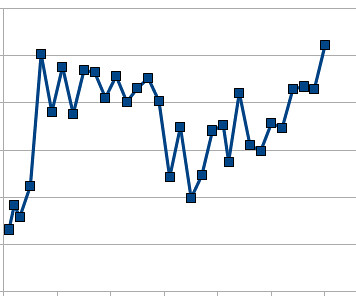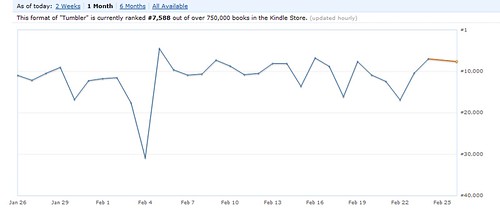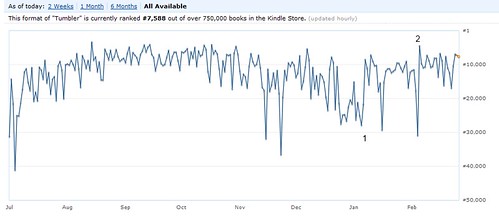 Recently, I took a bold new step in my publishing career. About nine months after I published my first book (Tumbler), I decided to pay real cash money to advertise it. Prior to that time, I had done nothing for promoting my book, outside of podcasting the story, and telling people about it on Facebook and Twitter. This was a huge step for me, and so I did a lot of research and study before taking the plunge.
Recently, I took a bold new step in my publishing career. About nine months after I published my first book (Tumbler), I decided to pay real cash money to advertise it. Prior to that time, I had done nothing for promoting my book, outside of podcasting the story, and telling people about it on Facebook and Twitter. This was a huge step for me, and so I did a lot of research and study before taking the plunge.
I decided to go with Kindle Nation Daily, a website that promotes Kindle books to their reading group of thousands. I chose their “eBook of the Day Sponsorship”, which included promotion on their “Planet iPad” sister site, a single post on their website with detailed information about the book and author, a FaceBook status post, a Twitter post, and a place on their sidebar for 18 hours. The whole package cost me $59.99 USD.
One of the reasons I went with this blog was the fact that I recognized some of the other authors there, specifically Basil Sands, author of “65 Below”. Another reason was that they posted their sales results, including a percentage of how much their authors sales improved after advertising with KND. The spreadsheets are very impressive, with some people seeing a thousand percent improvement or more.
I didn’t expect that level of return, but I figured that it was worth it if the ad only covered it’s own costs. I make around $2.09/book, so I knew I would need to sell 28 copies to cover the cost. If it could add four sales a day, then it would be worth it. So I gave it a shot.
The day before my ad appeared, a strange thing happened. Nobody bought my book. Please don’t think this is hubris talking, but that was a really odd occurance. On average, Tumbler sold about four copies a day. Not a bestseller by any scale, but it was fairly consistent. However, the day before my ad went up, sales stopped completely. Because of this, my Amazon Sales Rank shot up from #15,000 to #30,000. Not the best control case, to be sure, but there was nothing we could do about that.
Then, at around noon on the 5th of February, the ad showed up. Here’s a link to it. I didn’t write it, and I was kinda surprised to see the direction they took with it. Tumbler has always been a Heinlein-esque story. From the beginning, I wanted it to be a homage to one of my most favorite writers. I use Heinlein names, politics, and the by-your-bootstraps mentality that he so often shared. However the ad had a couple of references to Stieg Larsson. They refer to it as “Stranger in a Strange Land meets The Girl Who Escaped from Earth?” I get that one would want to tie a work to a bestseller, but that still seemed odd. I mean, there’s no intentional violence in my story, nor is there any sexuality or revenge. Still, if it would sell books, I guess it was their site. . .
And it did sell books. I don’t have sales numbers for the day, but I watched the sales total grow that day, and we definitely did sell at least 28 copies. In the space of one day, we dropped from #30k on Kindle Sales Rank down to #4358. We were listed in three different “Top 100” Amazon lists:
The effect didn’t last for long, but the sales did improve. Look at this:
In this graph, you can see the spike that came just before the ad went up, and you can see how the sales rank dropped on the day of the ad. Ever since that day, we have hovered around 10k, which isn’t bad, but look at this:
This is a graph of the sales rank for Tumbler over it’s entire run. In it, you can see how we started near #30k, and slowly dropped in rank as fans of the podcast began to pick it up. At that point, we were trending around #10k or lower. Then, as everyone knew it would, the trend diminished, sales got more erratic, and started to drop off.
In early January (footnote 1) I took a risky step that made a huge difference. I dropped the price of Tumbler from $4.99 to $2.99. The number of sales increased and (outside of a couple of abberant days) the sales rank dropped to around #15k. The $2.99 sales point made more money, and improved our sales rank. More than that, it fixed that dying trend, and flattened it at the same time. Compared to that, the ad placement (footnote 2) did not make a huge long-term difference.
Now, that doesn’t mean I’m unhappy with it. After all, even a slightly higher sales rank means more sales. I can’t complain about that. Also, the ad made back it’s investment in the first day. This is great news for an advertising client.
In short, it was definitely worth the expense, and I do plan to do it again for other books (I might even do it for Tumbler again in six months or so). But if one is looking for a way to significantly improve flagging sales numbers, a price drop might suit you better.
Update: Mr. Talbot points out that there is a difference between sales numbers and sales rank. This is a valid point, and while I don’t want to post specific sales data here, I thought I would share a graph of actual sales. You can see from this that, while the graphs are not identical, they do match fairly closely.




Great data! Thanks for posting it. I will note one thing – most authors are saying that it is much harder to rise in the rankings than it was even six months ago. I know one book I released last year hit about 7000 when I sold two copies in the first hour. A couple weeks ago, I released another book and sold 3 copies in the first hour and it only hit 10,000.
So I would go by sales numbers, not rankings if you’re charting anything over a couple months.
That’s a good point, and while I’m leery of posting specifics, I can say that, in this case, the sales numbers fit the rank. Gimmie a minute, and I’ll post a graph of it.